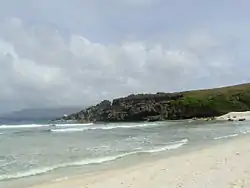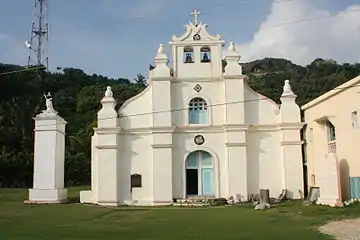Sabtang
Sabtang, officially the Municipality of Sabtang (Ivatan: Kavahayan nu Sabtang; Tagalog: Bayan ng Sabtang), is a 6th class municipality in the province of Batanes, Philippines. According to the 2015 census, it has a population of 1,621 people. [3]
Sabtang | |
|---|---|
| Municipality of Sabtang | |
 Island seascape | |
 Seal | |
 Map of Batanes with Sabtang highlighted | |
OpenStreetMap 
| |
.svg.png.webp) Sabtang Location within the Philippines | |
| Coordinates: 20°20′N 121°52′E | |
| Country | |
| Region | Cagayan Valley (Region II) |
| Province | Batanes |
| District | Lone District |
| Barangays | 6 (see Barangays) |
| Government | |
| • Type | Sangguniang Bayan |
| • Mayor | Maxilindo Emilio A. Babalo |
| • Vice Mayor | Marcial Armando A. Alavado |
| • Representative | Ciriaco B. Gato Jr. |
| • Electorate | 1,296 voters (2019) |
| Area | |
| • Total | 40.70 km2 (15.71 sq mi) |
| Elevation | 3.0 m (9.8 ft) |
| Population | |
| • Total | 1,621 |
| • Density | 40/km2 (100/sq mi) |
| • Households | 418 |
| Economy | |
| • Income class | 6th municipal income class |
| • Poverty incidence | 24.22% (2015)[4] |
| • Revenue | ₱37,353,343.97 (2016) |
| Time zone | UTC+8 (PST) |
| ZIP code | 3904 |
| PSGC | |
| IDD : area code | +63 (0)78 |
| Climate type | tropical monsoon climate |
| Native languages | Ivatan Tagalog Ilocano |
| Website | www |
The southernmost island municipality of the Batanes island group, Sabtang comprises primarily Sabtang Island, as well as two nearby smaller and uninhabited islands: Ivuhos and Dequey. The municipality is known for its lighthouse and the old stone houses of the Ivatan villages of Chavayan and Savidug. Like Batan Island to the north, Sabtang also has a few Mission-style churches and white sand beaches.
History
The Spanish missionary Fr. Artiquez first visited the Island of Sabtang in 1786[5] after receiving an affirmative response from the island to learn about the Christian faith. The success of the first visit led to two more evangelical trips resulting in the baptism of 181 children and the study of the catechism among the adult natives. The evangelization of Sabtang was cut short due to the failing health of the Spanish missionaries. For this, the inhabitants of Sabtang remained faithful to old traditions especially in the administration of justice by vendetta and murder.[5]
In 1791, the then most powerful chief in Sabtang named Aman Dangat showed defiance of the government of Governor Joaquin del Castillo by killing the Spanish soldiers who went to Sabtang to procure supplies. Lieutenant Tomas Nuñez led the troops to capture the rebels. Aman Dangat was put to trial and admitted to the crime. He, later on, asked to be baptized. The inhabitants of Sabtang were then forced to resettle in San Vicente and San Felix in Ivana to be better supervised by the government.[5]
Some forty years after the resettlement, the Sabteños were allowed to visit their native island and gradually these visits allowed them to build homes in their erstwhile land. The government allowed this to happen on the condition that houses should be constructed in lowlands.[5] To sustain the spiritual care for the Sabteños, a new mission was opened in Sabtang in 1845 under the patronage of Saint Vincent Ferrer with Fr. Antonio Vicente as its first vicar. Fr. Antonio Vicente is credited to have built the Sabtang Church, together with a convent, a school, and a courthouse.[5]
Geography
Sabtang is located at 20°20′N 121°52′E.
According to the Philippine Statistics Authority, the municipality has a land area of 40.70 square kilometres (15.71 sq mi) [2] constituting 18.58% of the 219.01-square-kilometre- (84.56 sq mi) total area of Batanes.
Barangays

Sabtang is politically subdivided into 6 barangays.[6]
| PSGC | Barangay | Population | ±% p.a. | |||
|---|---|---|---|---|---|---|
| 2015 [3] | 2010 [7] | |||||
| 020905001 | Chavayan | 9.7% | 157 | 169 | −1.39% | |
| 020905002 | Malakdang (Poblacion) | 14.4% | 234 | 245 | −0.87% | |
| 020905003 | Nakanmuan | 8.8% | 142 | 134 | 1.11% | |
| 020905004 | Savidug | 12.4% | 201 | 190 | 1.08% | |
| 020905005 | Sinakan (Poblacion) | 31.4% | 509 | 552 | −1.53% | |
| 020905006 | Sumnanga | 23.3% | 378 | 347 | 1.64% | |
| Total | 1,621 | 1,637 | −0.19% | |||
Demographics
| Year | Pop. | ±% p.a. |
|---|---|---|
| 1903 | 1,763 | — |
| 1918 | 1,665 | −0.38% |
| 1939 | 1,844 | +0.49% |
| 1948 | 1,656 | −1.19% |
| 1960 | 1,766 | +0.54% |
| 1970 | 1,359 | −2.58% |
| 1975 | 1,375 | +0.24% |
| 1980 | 1,409 | +0.49% |
| 1990 | 1,737 | +2.12% |
| 1995 | 1,434 | −3.53% |
| 2000 | 1,678 | +3.43% |
| 2007 | 1,465 | −1.85% |
| 2010 | 1,637 | +4.12% |
| 2015 | 1,621 | −0.19% |
| Source: Philippine Statistics Authority [3] [7] [8][9] | ||
In the 2015 census, Sabtang had a population of 1,621. [3] The population density was 40 inhabitants per square kilometre (100/sq mi).
Climate
| Climate data for Sabtang, Batanes | |||||||||||||
|---|---|---|---|---|---|---|---|---|---|---|---|---|---|
| Month | Jan | Feb | Mar | Apr | May | Jun | Jul | Aug | Sep | Oct | Nov | Dec | Year |
| Average high °C (°F) | 23 (73) |
23 (73) |
24 (75) |
26 (79) |
28 (82) |
29 (84) |
29 (84) |
29 (84) |
28 (82) |
27 (81) |
26 (79) |
24 (75) |
26 (79) |
| Average low °C (°F) | 22 (72) |
22 (72) |
23 (73) |
25 (77) |
27 (81) |
28 (82) |
28 (82) |
28 (82) |
27 (81) |
26 (79) |
25 (77) |
23 (73) |
25 (78) |
| Average precipitation mm (inches) | 44 (1.7) |
35 (1.4) |
29 (1.1) |
48 (1.9) |
204 (8.0) |
238 (9.4) |
291 (11.5) |
325 (12.8) |
304 (12.0) |
202 (8.0) |
141 (5.6) |
60 (2.4) |
1,921 (75.8) |
| Average rainy days | 11.1 | 9.1 | 8.3 | 9.2 | 15.7 | 17.1 | 19.4 | 21.9 | 21.1 | 18.4 | 16.3 | 12.4 | 180 |
| Source: Meteoblue [10] | |||||||||||||
Gallery
References
- Municipality of Sabtang | (DILG)
- "Province: Batanes". PSGC Interactive. Quezon City, Philippines: Philippine Statistics Authority. Retrieved 12 November 2016.
- Census of Population (2015). "Region II (Cagayan Valley)". Total Population by Province, City, Municipality and Barangay. PSA. Retrieved 20 June 2016.
- "PSA releases the 2015 Municipal and City Level Poverty Estimates". Quezon City, Philippines. Retrieved 12 October 2019.
- González Alonzo, Fr. Julio, O.P. (1966). "The Batanes Islands", in Acta Manilana, Manila: University of Santo Tomas Research Center
- "Municipal: Sabtang". PSGC Interactive. Quezon City, Philippines: Philippine Statistics Authority. Retrieved 8 January 2016.
- Census of Population and Housing (2010). "Region II (Cagayan Valley)". Total Population by Province, City, Municipality and Barangay. NSO. Retrieved 29 June 2016.
- Censuses of Population (1903–2007). "Region II (Cagayan Valley)". Table 1. Population Enumerated in Various Censuses by Province/Highly Urbanized City: 1903 to 2007. NSO.
- "Province of Batanes". Municipality Population Data. Local Water Utilities Administration Research Division. Retrieved 17 December 2016.
- "Sabtang, Batanes : Average Temperatures and Rainfall". Meteoblue. Retrieved 5 January 2019.
External links
| Wikimedia Commons has media related to Sabtang, Batanes. |
